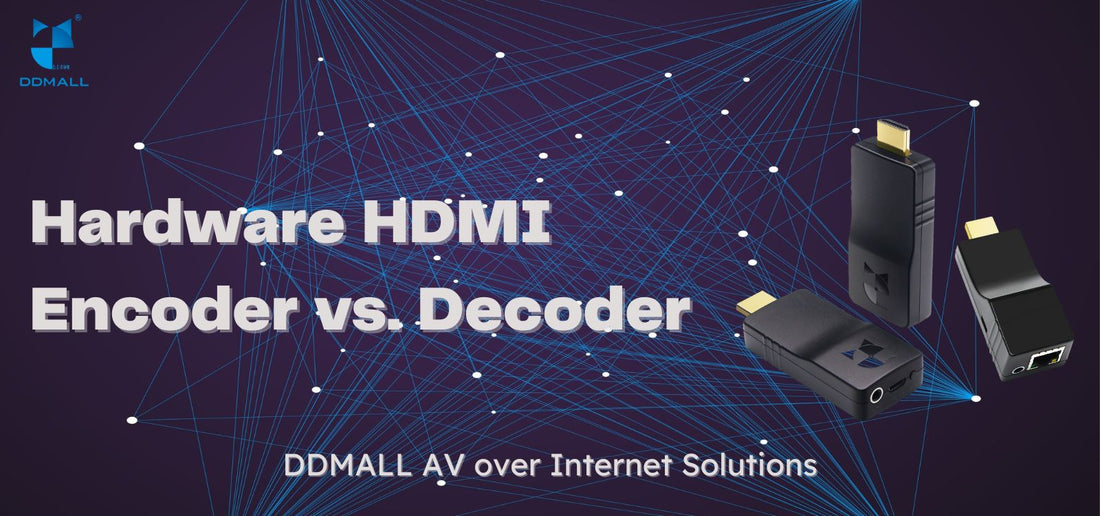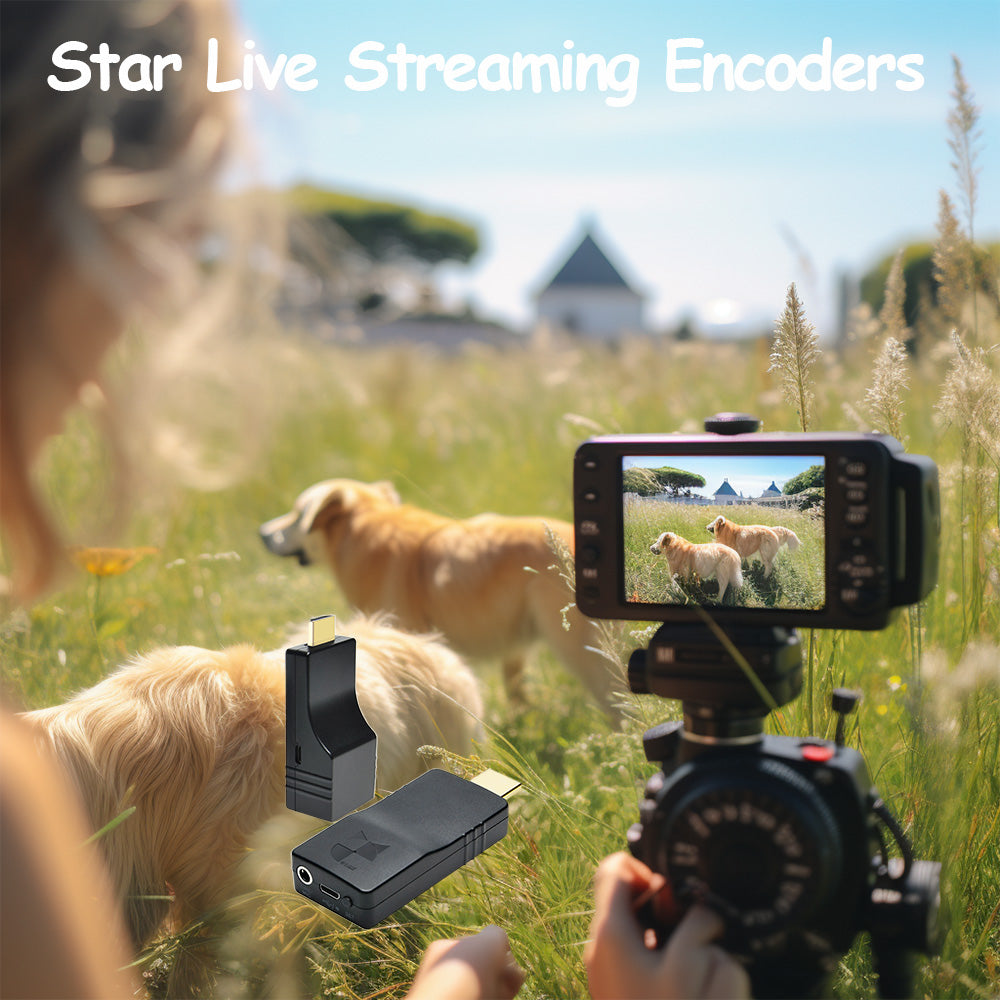
What’s the Difference of Hardware HDMI Encoder and Decoder: A Comprehensive Guide
Share
Sending and receiving videos is important. Different types of videos need special codes put into them during sending and special codes taken out during receiving.
Not all video types use the same codes.
Table of Contents:
- Understanding the Distinctions: Hardware HDMI Encoder vs. HDMI Decoder
- What is a Hardware HDMI Encoder?
- Definition and Functionality of a Hardware HDMI Encoder
- Advantages of Using a Hardware HDMI Encoder
- Common Applications of Hardware HDMI Encoders
- What is a Hardware HDMI Decoder?
- Definition and Functionality of a Hardware HDMI Decoder
- Advantages of Using a Hardware HDMI Decoder
- Common Applications of Hardware HDMI Decoders
- Key Differences Between Hardware HDMI Encoder and HDMI Decoder
- Video Encoding vs. Video Decoding Process
- Performance and Efficiency Comparison
- Cost Considerations
- Compatibility and Integration
- Scalability and Flexibility
- Choosing the Right Option: When to Use a Hardware HDMI Encoder or HDMI Decoder
- Can a Hardware HDMI Encoder be used as a HDMI Decoder (and vice versa)?
- Conclusion: Making an Informed Decision
Software on computers can do the coding and decoding but special video hardware works better. It can do the coding and decoding much faster while keeping the video looking good. This is especially important when the video is important, like for movies or live events.
Understanding the Distinctions: Hardware HDMI Encoder vs. HDMI Decoder
What is a Hardware HDMI Encoder?
Definition and Functionality of a Hardware HDMI Encoder
A hardware encoder can be defined as a physical device that changes pictures and sounds from real life into a special code that computers and phones can understand.
It takes analog signals as inputs and converts them into digital code outputs. The core function is to translate analog information into a digital format that can be more easily processed and transmitted by other electronic systems.
For example, the iptv encoder hdmi takes inputs from cameras and microphones and turns them into digital codes that can be sent to other devices and played back.
Advantages of Using a Hardware HDMI Encoder
Hardware encoders have some benefits over using software on computers to do the encoding. They can change the inputs into codes very fast without slowing down the computer. They allow for real-time, low latency encoding without relying on system CPU/GPU resources. This makes them good for live videos like news or sports games. They also make the video quality stay better even with lower file sizes compared to software. Also, hardware encoders are made to run encoding non-stop for a long time.Common Applications of Hardware HDMI Encoders
- IP-based live streaming of CCTV/security camera feed
- Broadcast of IPTV/OTT TV channels over fiber, satellite or cable networks
- Corporate video conferencing through dedicated encoders
- Distance learning systems with centralized encoding hardware
- Digital signage distribution networks for advertising or information
- Live sports streaming for broadcasters and streaming platforms
- Hotel/Airbnb IPTV system integration through encoders
- Medical imaging distribution within a hospital via IP networks
What is a Hardware HDMI Decoder?
Definition and Functionality of a Hardware HDMI Decoder
A hardware video decoder is a complementary device that performs the reverse function of a hardware encoder. It decodes a compressed digital video/audio stream back into an uncompressed analog format suitable for display. Hardware decoders accept digitally encoded inputs in formats like AVC/H.264, HEVC/G.265 etc. from IP streams or storage and then decode them in real-time. The decoded analog output can be in HDMI, VGA, SDI or other standard video outputs.
Advantages of Using a Hardware HDMI Decoder
Some key benefits of using hrdware decoders include their ability to decode high bitrate streams smoothly without choking system resources. This makes them suitable for demanding commercial applications requiring 24/7 decoding. The hevc video decoders offer high picture quality by supporting advanced codecs. Hardware decoders also have various ports for integrating different end devices. Their ruggedized design enables use even in extreme environments. Integrated decoders also allow for flexible playback of multi-screen configurations on different connected displays.Common Applications of Hardware HDMI Decoders
- Digital signage and menu board systems
- IPTV/OTT set-top boxes and media streamers
- Video walls with multiple integrated displays
- Security camera video management systems
- Medical imaging diagnostic workstations
- AV receivers in pro audio-visual installations
- Flight entertainment systems in airplanes
- Cruise infotainment and onboard CCTV systems
- Conference room and classroom presentation appliances
Key Differences Between Hardware HDMI Encoder and HDMI Decoder
Video Encoding vs. Video Decoding Process
The fundamental difference lies in their processing functions - encoders compress incoming source content while decoders decompress encoded streams for playout. Encoders digitize, compress and multiplex analog inputs while decoders do the reverse - decompress, demultiplex and render digital streams into analog outputs.
Performance and Efficiency Comparison
In performance, ip encoders tend to consume more power and have higher hardware specs than decoders as encoding is a more resource-intensive process than decoding. However, dedicated encoder/decoder solutions provide better quality than software-based encoding/decoding.
Cost Considerations
In general, hardware encoders tend to be more expensive than decoders due to higher specs needs. Encoder pricing also depends on number of input/output channels and encoder density/channels per device. But over time, costs have reduced due to commoditization.
Compatibility and Integration
Interoperability is an important aspect - encoders and decoders must work together seamlessly based on standardized encoding formats. Optimized hardware pairs ensure glitch-free encode-decode workflows. Mismatch of encoder-decoder capabilities can impact quality, integration, or operation.
Scalability and Flexibility
Encoders offer better scalability as their channel counts can be expanded easily. But decoders provide flexibility through multi-screen playback without reliance on host infrastructure. Both excel at distributed, redundant applications through clustered encoding/distributed decoding architectures.
Choosing the Right Option: When to Use a Hardware HDMI Encoder or HDMI Decoder
Scenarios Favoring Hardware HDMI Encoders
- High-volume live streaming events demanding real-time encoding- Professional broadcasting with stringent quality requirements and the need for efficient compression
- Applications requiring immediate content delivery with minimal latency
Scenarios Favoring Hardware HDMI Decoders
- Home entertainment systems where high-quality playback is paramount- Digital signage solutions for public displays demanding clarity and precision
- Video surveillance setups requiring accurate and swift decoding for real-time monitoring and analysis
Can a Hardware HDMI Encoder be used as a HDMI Decoder (and vice versa)?
In general, a hardware hdmi encoder cannot be used directly as a hdmi decoder, and vice versa. This is because they are specifically designed and optimized for their respective tasks.
-
Encoding vs. Decoding:
A hardware encoder is specifically engineered to convert uncompressed video or audio data into compressed formats, reducing file size and optimizing transmission or storage. It employs algorithms and hardware optimizations tailored for this purpose. On the other hand, a hardware decoder is designed to decode compressed video or audio data back into an uncompressed format for playback or processing. -
Compression Algorithms:
Hardware encoders and decoders rely on specific compression algorithms to achieve efficient data compression and decompression. These algorithms are optimized differently for encoding and decoding tasks. For example, an H.264 hardware encoder employs encoding algorithms specific to H.264 compression standards, while an H.264 hardware decoder uses decoding algorithms specifically designed for the same standard.
Attempting to use a hardware encoder as a decoder, or vice versa, would result in compatibility issues, inefficient decoding, and potentially erroneous results.
However, it is worth noting that some devices or systems may incorporate hybrid solutions that combine both encoding and decoding capabilities in a single hardware unit. These solutions are specifically designed to handle bidirectional video or audio processing. In such cases, the hardware unit includes dedicated components for encoding and decoding, allowing it to perform both functions effectively.
In summary, while a hardware encoder cannot be used as a decoder, and vice versa, they are complementary components in hybrid solutions, working together to achieve efficient multimedia processing.
Conclusion: Making an Informed Decision
In conclusion, this comprehensive guide has illuminated the nuanced differences between hardware hdmi encoders and hdmi decoders. Armed with this knowledge, decision-makers can navigate the ever-evolving landscape of audiovisual technology with confidence.
Whether encoding for efficient transmission or decoding for seamless playback, choosing the right hardware is paramount for optimal performance in diverse applications.
As technology continues to advance, staying informed about the capabilities and nuances of hardware encoders and decoders becomes increasingly vital.
Organizations that leverage these devices effectively will not only meet current audiovisual needs but also position themselves to adapt to future advancements, ensuring a seamless and high-quality user experience.

